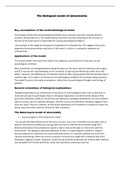Class notes
Class notes biogical model of abnrmality (PSYCH101)
- Course
- Institution
it is an elaborated document of the biological model of abnrmality with a lot of different case studies and reseachers names, methods , medication used, key ppints application of different models. this also inclued psychodynamics, behaviour models, cognitive mdel along with elaborated information o...
[Show more]



